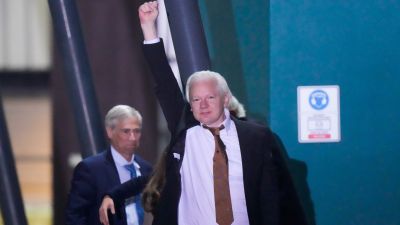
Wikileaks founder Julian Assange arrived in Australia today after he was freed by a United States court in Saipan under a plea deal.
Assange’s plane landed in Canberra on Wednesday, hours after the 52-year-old pleaded guilty in a court in Saipan to a charge of espionage, related to obtaining and publishing US military secrets.
The Australian had earlier flown into Saipan from the UK on a private aircraft. He walked into the court accompanied by members of his legal team and Australia’s ambassador to the US, former Prime Minister Kevin Rudd.
Addressing the court, Assange said he believed the Espionage Act under which he was charged contradicted First Amendment rights in the US Constitution, but that he accepted that encouraging sources to provide classified information for publication could be unlawful
Fidel Narvaez, a former Ecuadorean diplomat who gave Assange political asylum at Ecuador’s embassy in London in 2012, told Al Jazeera that he felt “overwhelmed by joy” that Assange was released.
“I am celebrating, of course,” Narvaez said, adding that Assange has been facing “persecution by the most powerful country in the world” for 14 years, while simultaneously being abandoned by his own country.
Narvaez pointed out that Assange would probably not have taken a guilty plea deal had it been offered to him years ago, noting that this has set a precedent that will discourage others from repeating his actions in the future.
Wikileaks has shed light on the Sri Lankan conflict revealing that British and American officials were aware of the war crimes being committed by the Sri Lanka state during the final stages of the war.
A leaked US Embassy cable says,
There are no examples we know of a regime undertaking wholesale investigations of its own troops or senior officials for war crimes while that regime or government remained in power. In Sri Lanka this is further complicated by the fact that responsibility for many of the alleged crimes rests with the country's senior civilian and military leadership, including President Rajapaksa and his brothers and opposition candidate General Fonseka.”
See the full text of a US Embassy cable of January 2010, released by Wikileaks to The Guardian newspaper here.
Sri Lanka refuses to accept mediated surrenders or evacuate the wounded
A leaked US Embassy cable says,
Ambassador spoke to Gothabaya Rajapaksa on the morning of May 17 to urge him to allow the ICRC into the conflict zone to mediate a surrender.
Rajapaksa commented, "We're beyond that now".
Ambassador contacted senior GSL officials throughout the day, including Secretary of Defense Gothabaya Rajapaksa and Foreign Minister Bogollagama, to urge acceptance of a mediated surrender of the remaining Tigers and maximum restraint on the part of the military to avoid further civilian casualties, particularly after the reports from the Bishop of Mannar of continued high numbers of civilians in the safe zone.
Rajapaksa refused to accept mediated surrender on the grounds that the fighting was all but over, but said troops had been instructed to accept anyone who wishes to surrender.
A leaked US Embassy cable says,
"Ambassador spoke to Presidential Advisor Basil Rajapaksa to request access for the ICRC to evacuate dead and wounded. Rajapaksa refused, contending the GSL could manage on its own."
"Ambassador called Basil Rajapaksa to note the reports of many dead and wounded lying in the conflict zone, and again requested access for the ICRC to the area to evacuate the wounded. Basil energetically refused… Rajapaksa noted that the Army was evacuating wounded civilians by air to Anuradhapura and could deal with the current situation by itself."
